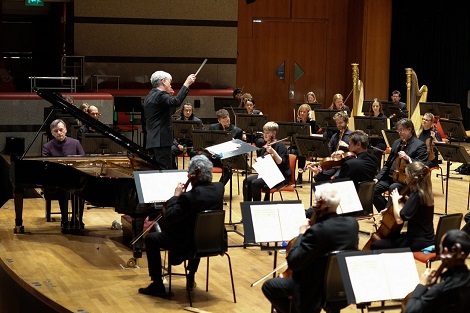Simon Hale watches the CBSO’s long-awaited return to Symphony Hall.
It was a triumphal and emotional homecoming for both orchestra and audience as Symphony Hall once again reverberated to the sound of applause.
Returning to live performance for the first time this year after the lifting of pandemic curbs, the City of Birmingham Symphony Orchestra fielded a full team of more than seventy musicians for such a celebratory concert.
The CBSO was able to achieve the numbers while maintaining social distancing by extending the stage, removing the choir stalls and having everyone play on a wider flat space with wooden panels as the backdrop.
“I want to say a huge thank you for having the courage to return and for your unfaltering support,” said CBSO clarinettist and long service award winner Jo Patton in a brief speech to the matinee crowd.
Conductor and long standing CBSO collaborator Edward Gardner went on to add: “It’s an incredibly moving day to have you all back here again.”
The music was almost secondary to the near-miracle of the occasion, but it was clear from the back of the upper dress circle how the concert regulars thrilled to the little more than a one-hour programme without an interval.
There was no traditional overture followed by a symphony but three suitably summery works of twenty minutes or so beginning with a performance of Saint-Saëns’ Fourth Piano Concerto, with the great Stephen Hough on the ivories. His delightfully assured playing, bringing a dreamlike quality to the wonderful melodies, was rapturously received, with the audience calling him back to the stage several times in their appreciation.
Two pieces on the theme of the sea followed, with the orchestra almost dancing through the beautifully elegiac tone poem Violent, Violent Sea by the young American Missy Mazzoli, better known for her opera, Breaking the Waves, adapted from the Lars von Trier film. The impression though was more heaving current than storm.
Debussy’s great crowd-pleaser La Mer however brought a wonderfully impressionistic and oriental conclusion to proceedings – we even had Hokusai’s famous print of The Hollow of the Wave off Kanagawa shown on a screen that also introduced us to the three movements.
The third movement – A Dialogue between the Wind and the Sea – was a perfect showcase for the brass and percussion whose sound seemed richer and amplified by the wooden backdrop in front of which they were positioned. Let us hope the CBSO continues with the new format and gives us the chance to experience more shorter works in the new normal.
CBSO live performances continue on May 26th with matinee and evening performances of Shostakovich’s Fifth Symphony, Stravinsky’s Symphonies of Wind Instruments and Britten’s Lachrymae: cbso.co.uk
